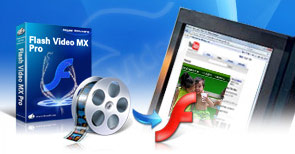Flash Video MX Pro
- Video conversion to FLV & SWF
- DVD conversion to FLV & SWF
- Flash 8 video encoding
- Flash 8 Alpha video video encoding
- Flash Player with brilliant skins
Flash Video MX Pro is capable of adding cue points in the generated Flash video (FLV) files. This is a great feature which allows you to synchronize video clips with other Flash elements. Cue points are invisible markers in a video file which can be used to trigger external events such as synchronizing graphics, subtitles, etc; providing navigation options; loading other video files or SWF movies, etc.
Cue points don't do anything by themselves. They are merely passive markers. To make use cue points you need to write some Actionscript in the SWF file which contains the Flash Video file. The Actionscript code "listens" to the preset cue points and takes whatever action you specify when it encounters one.
With the CuePoint, professional users can import single video file for encoding or multiple video files for encoding at once.
Launch Flash Video MX Pro; add CuePoint; see the pictures below:
When the video plays to the frame that you want to add cue point, click the Add button and select a cue point type from the pop-up list. There are two types of cue point you get: Add Event, Add Navigation. If you want to delete the selected cue point, just click the button named “Delete cuepoints”.

After you finish your setting, then the cue point effect will be appear in the output file you get in the end.
Generally, Cue Points can be embedded in the FLV file when you encode it. This creates permanent cue points. When the FLV file is played to a preset time point, it will trigger the onCuePoint Event. If you don't want to apply the player offered by the Flash Video MX, you can apply your Action Script to play FLV, coding like the following:
var nc = new NetConnection(); //construct a NetConnection Object
nc.connect(null); //make a connection
var ns = new NetStream(nc); //construct a NetStream Object with nc
videoScr.attachVideo(ns); //videoScr is a video instance placed in the scene
ns.play("xxx.flv"); //to start play the video, xxx.flv is your flv name, it can be an absolute or relative URL
ns.pause(true); //pause video
ns.pause(false); //resume to play video
ns.seek(t); //seek to t seconds
ns. onCuePoint = function(info)
{
trace(info.name); //get cue point name
trace(info.time); //get cue point time in seconds
trace(info.type); //get cue point type, "event" or"naviagtion"
trace(info.parameters["param_name"]); //get cue point's param_name value
}
If you apply the player offered by the Flash Video MX to play the FLV file, you can handle Cue Point Event like the following. Please refer to the document for Player API for more details.
var listener:Object = new Object();//construct an event listener object
listener.onEvent = function(sender, type, name, info)
{
if (name == "onCuePoint") {//handle onCuePoint event
trace(info.name);//get cue point name
trace(info.time); //get cue point time in seconds
trace(info.type);//get cue point type, "event" or"naviagtion"
trace(info.parameters["param_name"]);//get cue point's param_name value
}
}
thePlayer.AddListener(listener);//add event listener so that the listener can get the "onCuePoint" event.